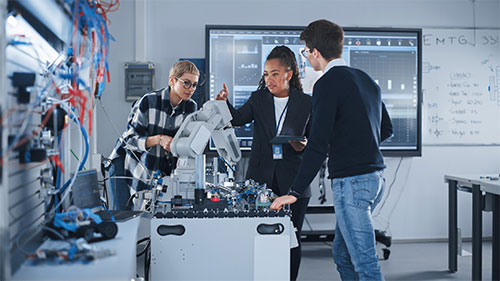The National Physical Laboratory (NPL) is developing new ways to measures electricity at the single electron level. Find out more about electricity and how quantum physics is helping us control and measure it.
In our technology-filled world it is vital to control and measure electricity really well. The job of an electrical metrologist is to make sure we can measure how much electricity something uses or produces by comparing it with a standard quantity, which defines its measurement unit. The principal electrical unit is called the ampere - or the amp - and it is a rate of flow of charge. The tricky thing about electricity is that you can't actually see how much current is flowing in a cable by looking at it or listening to it. There is a huge range of electrical current in different devices from thousands of amps in an electric car to a trillionth of an amp in an air quality sensor.

The ampere is the unit of electrical current
The first electrical metrologists, like Ampere in the 1800s, saw that electricity ‘flowed like a river’ and had the power to ‘move stuff’ so they called their electrical flow a ‘current’ and measured it with mechanical effects. They suspected electricity might be granular or ‘lumpy’, but they couldn’t see this because the lumps (which we now know as electrons) were too small.

Electricity is the flow of charged particles called electrons
Using quantum nanotechnology we can now investigate and manipulate electricity one electron at a time. We can’t see electrons with our eyes, but experiments tell us how they behave and how electricity can be controlled. This means we can create a standard quantity of electricity by counting electrons.
In practice we use a very, very narrow conductor and two tiny electrodes. These create a 'force field' which acts as an electron trap. We pop electrons into and then out of the trap one-at-a-time using a very accurate timing signal.

Single electron pumps like this can trap and release single electrons
Yes really! Our electron pump is like a tap that delivers one electron per 'tick' of our signal generator clock that runs really quickly (1 billion electrons per second is typical). We can direct this current through regular wires into an external circuit for calibrations and other tests.
Before quantum nanotechnology existed, this would seem like a crazy idea. Even now it requires a lot of fancy semiconductor engineering, cryogenic (very low temperature) hardware and electronics. But it really is the most fundamental way of creating a known quantity of electricity. You can express electrical current as 'electrons per second' multiplied by the charge each electron carries. It’s an incredibly simple concept, and one that now we can carry out in our laboratories.
Manufacturing, healthcare, space exploration and business are all supported by robust measurement standards of many physical quantities. And it nearly always involves electrical measurements, in some form. We are all surrounded by - and rely upon - electrical metrology all the time, we just don’t realise it!
NPL is the UK's National Metrology Institute. This means that we make sure that measurement standards are always fit for purpose and ready for new advances in technology. This includes taking on extreme challenges like counting electrons.

Electrical measurements take place everywhere - from factories to hospitals to labs
Most measurements of large current don’t need the extreme accuracy of microscopic electron counting, but there are some really important reasons why it is a neat technology.
As far as we know, all the electrons on earth and in the universe are exactly the same. This makes electron-counting a route to a standard that is truly 'universal'. It doesn’t matter exactly which electrons you count or where, or when. This robustness and universality is particularly valuable on the frontiers of science and technology, where other things are unknown.
Scientists are often trying to discover new things, improve people’s health, protect the planet and other lofty goals. This often means measuring and interpreting sensor signals. Sometimes these signals are really tiny and difficult to measure accurately - environmental sensors are often like this. Standards for small electrical current measurement, including electron counting, will help make this sensor data meaningful.
In fact, since the redefinition of the electrical units in 2019, all measurements of electricity are ultimately related to numbers of electrons even when they are not being counted one at a time.

Counting electrons is a good way to measure electricity at low currents
We engineer and control our single electron trap so that it 'almost certainly' moves a single electron in every tick of our pumping clock. But what do we mean by 'almost certainly'?
We spend a lot of time measuring how close to perfect our electron counting can get. At the moment we think we can make less than one mistake (a missing or extra electron) in every million cycles. If you can count to 1 million and make zero mistakes then you are doing better than us. This accuracy is already good enough for some measurement problems and has already helped us make more accurate measurements at low current levels.

Our ability to trap single electrons reliably sets the accuracy of our standard
Quantum physics explains the behaviour of atoms, electrons and photons. It is famous for being a bit tricky to understand and counter-intuitive. It causes endless debates over whether 'stuff' is more 'wave-like' or 'particle-like' - or whether Schrodinger's cat is doing well (or not!).
Despite its apparent weirdness, quantum theory is one of the most thoroughly tested theories ever. Quantum physics has enabled the development of semiconductor electronics, lasers, atomic clocks and many other essential technologies. Importantly for a metrologist, quantum physics gives access to unchanging measurement standards - not just electricity but in all physical measurements.

Our lives are all touched by quantum technologies
There is always some nostalgia for old fashioned metrology tools…such as a metal object to define length and mass or a chemical battery to define the voltage standard. They might feel easier to understand, but this 'old school' approach is full of pitfalls. Artefacts or non-quantum physical standards change with measurement conditions, handling or just time. This creates practical problems and accuracy limitations when using them for calibration or real-world measurements.
Quantum standards look more complicated, but they are inherently stable. Because physical laws are perfectly reproducible, each quantum standard behaves in exactly the same way. You can’t 'copy and paste' artefacts and make them exactly the same, but you can with quantum standards.

The technology and expertise that we use for single electron pumps and quantum standards are closely related to those being used to build quantum computers or quantum sensors. This is not a coincidence! Quantum computing and quantum metrology both depend on controlling very sensitive quantum systems.
Quantum computing relies on creating an isolated physical system with a limited number of accessible quantum states which can be controlled to perform computations. This is an extreme challenge - which is potentially even more challenging than counting electrons!
This app is an exciting way to explore the world of measurement and have some fun, learning a thing or two along the way! Download the app and accompanying poster pack to join the quest!
Our research and measurement solutions support innovation and product development. We work with companies to deliver business advantage and commercial success.
Contact our Customer Services team on +44 20 8943 7070